Heřmanův Městec
Heřmanův Městec (Czech pronunciation: [ˈɦɛr̝manuːf ˈmɲɛstɛts]; German: Hermannstädtel) is a town in Pardubice Region of the Czech Republic. It is located at the northern foothills of the Iron Mountains (about 10 km west of Chrudim and 87 km east of Prague) at an altitude of 275 meters above sea level. It has a population of around 4,800 inhabitants.
Heřmanův Městec | |
|---|---|
Town | |
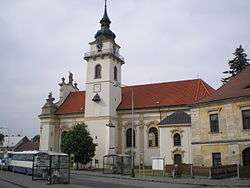 Saint Bartholomew Church | |
 Flag 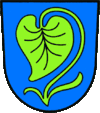 Coat of arms | |
 Heřmanův Městec Location in the Czech Republic | |
| Coordinates: 49°56′51″N 15°40′5″E | |
| Country | Czech Republic |
| Region | Pardubice |
| District | Chrudim |
| First mentioned | 1325 |
| Government | |
| • Mayor | Josef Kozel |
| Area | |
| • Total | 14.34 km2 (5.54 sq mi) |
| Elevation | 280 m (920 ft) |
| Population (2019-01-01[1]) | |
| • Total | 4,835 |
| • Density | 340/km2 (870/sq mi) |
| Time zone | UTC+1 (CET) |
| • Summer (DST) | UTC+2 (CEST) |
| Postal code | 538 03 |
| Website | www.hermanuv-mestec.cz |
Notable people
- Jiří Stanislav Guth-Jarkovský (1861–1943), writer, co-author of the Olympic Charter, president of the Czech Olympic Committee (1899–1929)
The Jewish Community of Heřmanův Městec
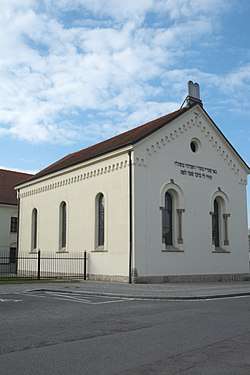
Jews were living in Heřmanův Městec as early as the first half of the 15th century[2] and it represents one of the oldest documented Jewish communities in the Chrudim District.[3] A minyan (10 adult Jewish males) was recorded as early as 1570.[4] The Jewish community continued to grow and thrive over the years.
Eventually, Heřmanův Městec became the seat of the district rabbi. The Jewish population peaked in 1849 at 840 and began to decline as both Jews and non-Jews left rural areas to pursue employment in cities as part of the industrial revolution. During the occupation by Nazi Germany during World War II, most of the approximately 60 remaining Jews were deported to the Tereźin concentration camp in December 1942.[2] Few survived the war and the Jewish community was effectively destroyed. In 2001, through the efforts of the local inhabitants, the Jewish cemetery was restored along with the Synagogue and rabbi's home which now serve as a cultural center.
The Beginnings of a Jewish Community in Heřmanův Městec
The town was the property of a series of aristocratic landowners who enjoyed a mostly positive relationship with the Jewish community.[2] The Jewish community paid a fixed annual sum of money to the landowning gentry.[2] During the 16th, 17th, and 18th centuries, Jews living in the town were mainly engaged in trade (linen, wool, hides, or feathers) and money-lending.[2][5] The location of the town along the road connecting Prague with Moravia brought a great number of merchants into the area.[2] A Jewish settlement grew up on single street (now Havlickova Street) which eventually had its own mayor, police, and other officials.[2]
According to oral tradition, the Jewish cemetery in town dates back to the 1430.[4] Usually, when Jews move into an area, one of their first community actions is to purchase land for a cemetery. There is documentation from 1667 that additional land was purchased for the purpose of enlarging the Jewish cemetery.[2][5] There are records of additional extensions that took place in 1685, 1709, 1723[2][6] and 1838.[4][6] The cemetery eventually reached almost 4,000 square meters.[4][6] In 1643, the Jewish community united to form a Chevra Kadisha (or burial society).[6] The date of the construction of the first synagogue is unclear, but it was destroyed in a large town fire in 1623.[6][2]
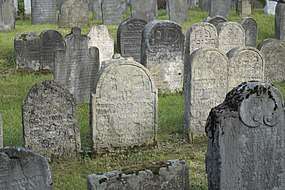
In 1661 the Count Jan Karel Špork became the owner of the estate which included the town.[3][6] Under his administration, the local Jewish community flourished. The Count encouraged Jews to move into houses that were abandoned during the Thirty Years' War along a single street leading to the Jewish cemetery (now called Havlickova Street).[6] He allowed the Jews to rebuild their synagogue, which was destroyed in the 1623 fire.
In 1680 the town was visited by a plague that claimed many lives, leaving a large number of dilapidated houses behind. In 1686, Count Ferdinand Leopold Špork called upon the Jews from the region to inhabit the abandoned houses.[3][4] At the turn of the 17th century the town became the seat of the regional rabbi.[3]
Repression and Emancipation 1726–1939
The ruling Habsburgs introduced restrictions on Jewish movement, residence, marriage, and other matters of everyday life. In 1727 the vice regent's office in Prague confirmed a regulation concerning the distance between Jewish dwellings and Christian churches that led to the synagogue of Heřmanův Městec being torn down because it was too close to the town's Catholic church. Eventually, Jewish self-government was abolished, and the Jewish settlement was surrounded by an enclosure with three gates. All Jews were required to live in this part of town, effectively establishing a Jewish ghetto in Heřmanův Městec.
Until construction of a new synagogue in the Baroque style in 1760, the Jewish community used a private home as a house of prayer.[2] Count Jan Václav Špork, who then owned the town's land, is said to have financially supported construction[6] and laid the foundation stone for the new synagogue, which is in the same location as the current synagogue.[6]
For over a century the Jews of Bohemia including the Jews living in Heřmanův Městec had to endure a number of restrictions with regard to employment, where they could live, what they could study, and limitations on marriage. For a period only the first-born sons were allowed to marry.[2] Despite the restrictions of the ruling Habsburgs, the relationship with the local gentry (i.e., the Špork family) was generally positive.
In 1848 serfdom was abolished, and the Jews living in Heřmanův Městec were emancipated and allowed freedom of movement. As a result, many Jews left the town for employment opportunities in industrialized cities such as Prague or emigrated abroad.[7]
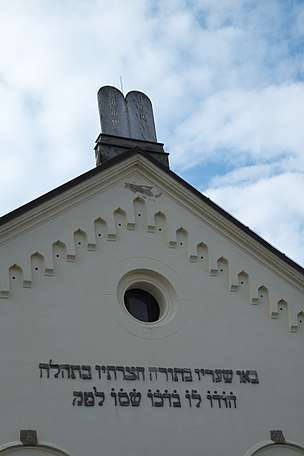
In 1870 construction of new synagogue, with the backing of the aristocratic landowner, on the same site as the 1760 building was started.[2] This building was in the Neo-Romanesque style by the architect Frantisek Schmoranz.[2][6] The architect had some lofty plans which had to be abandoned because the Catholic clergy feared that the synagogue might outshine the nearby St. Bartholomew's church.[2][6] The original design had a tower with a stairway leading to the women's gallery. After design changes, the synagogue provided access to the women's gallery via a covered passageway from the school building next door.[2] A stone-hewn image of the Ten Commandants adorned the top of the building. Due to the reduction in size, the building was not really sufficient to support the large crowds which attended worship services especially on holidays.[2] As the Jewish population declined toward the latter part of the 19th century, the building became sufficient.[2]
With the relaxation of restrictions on Jews, by the late 1800s the town and its Jewish inhabitants had a thriving role in the production of shoes.[2] There were several Jewish-owned handmade and machine-made shoe production companies. The Falk family owned a handmade shoe factory; and the Löwit family production company had a shoe factory in town that employed 300 workers.[6] Most of these companies had international exports. As Jews were now permitted to study without restriction, many of them also pursued opportunities as attorneys, physicians, and other professions.[3] In 1891, Heřmanův Městec became the seat of a district rabbi, with the dependent communities being Chrudim, Hroubovice, and Drevikov. This was a logical decision given that the Heřmanův Městec Jewish community had a long established protected status, a positive relationship with the landowning gentry of the town, and had a rabbi in residence. While the town itself had less than a 100 Jewish inhabitants, it served a broader Jewish community of 500 Jews in the region including Chrast, Chrudim, Hroubovice, Přestavlky, Slatiňany, Hlinsko, Svratká, Trhova Kamenice, Nasvrky, and Seč.[2]
German Occupation 1939–1945
On March 16, 1939, Nazi Germany established the Protectorate of Bohemia and Moravia. The Heřmanův Městec Jewish community was now under the rule of Nazi Germany and the Nuremberg Laws restricting Jewish rights were the law of the land. In 1940, Jews living in the Protectorate were deprived of the ability to do business, they were dismissed from government service, Jewish children were denied the right to attend school, and worship and assembly were forbidden. In Heřmanův Městec the Ten Commandants on the synagogue were removed, and the building was used by the German army for storage. Local residents planted vegetation around the Jewish cemetery in an attempt to hide it from the view of the German occupiers.
On December 3, 1942, most of the Jews of Heřmanův Městec (approximately 60) were ordered to assemble at a meeting point in the nearby town of Pardubice and transported to the Tereźin concentration camp two days later.[2] Many of those were eventually transported to Auschwitz.
During the occupation by Nazi Germany, Jewish ritual objects, including over a dozen Torah scrolls, were transported to the Jewish Museum in Prague. These eventually became part of the Memorial Scrolls Trust collection housed at the Westminster Synagogue in London. It is likely that so many Torah scrolls were attributed to Heřmanův Městec because it was the seat of the district rabbi. As the Jewish community in the area shrank during the late 1800s and early 1900s and other synagogues closed their doors, their Torah scrolls probably were sent to the synagogue in Heřmanův Městec. Thus, by 1940, Heřmanův Městec had a large inventory of Torah scrolls.
Postwar and Restoration
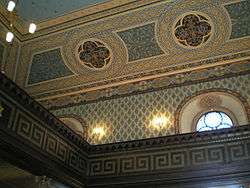
In 1945 at the end of World War II, only two members of the Jewish community returned to Heřmanův Městec. The once thriving Jewish community in the town was now effectively gone.[2] After World War II the synagogue was used mainly as a warehouse.[5] The synagogue, rabbi's house, and cemetery received little maintenance or care and deteriorated. At one point, the Bohemian Brethren Evangelic Church purchased the synagogue and adjacent rabbi's house which were used as a storeroom and a prayer house, respectively.[6-] Many of the former homes of the Jewish community were razed between 1980 and 1982 as part of a redevelopment effort.[2]
In 1986 the Town of Heřmanův Městec purchased the synagogue. The Jewish Culture Preservation Society was established in Heřmanův Městec at the suggestion of Ladislav Mareš, a son of Hermína Marešová, a Jewish woman who had married a non-Jew prior to World War II. Ladislav Mareš was not deported during the Nazi occupation because he was not registered as part of the Jewish community. Hermína Marešová was liberated from Bergen-Belsen and returned to Heřmanův Městec after the war.
The Jewish Culture Preservation Society raised funds and coordinated efforts to restore important Jewish sites in Heřmanův Městec. In the early 1990s much of the cemetery was restored. Wild vegetation was cleared, gravestones were reset and inventoried, the surrounding walls were repaired, and the Chevra Kadisha building (aka mortuary) and caretaker's home were restored. In 1991, the synagogue and the Jewish cemetery of Heřmanův Městec were declared national cultural monuments.[2][8] Using plans from 1870, the synagogue building and adjacent rabbi's house were restored in 2001. The synagogue was furnished with replicas of the original benches, and the painting and stained glass windows were restored. The only major architectural change is the size of the bimah (area where the Torah is read). It was enlarged to better serve as a stage in support of its new role as a concert hall. The rabbi's house is now the home of the Cyrany art gallery.[6]
The Jewish Cemetery
The Jewish cemetery, which dates from the 15th Century, is among the oldest and best preserved Jewish cemeteries in the Czech Republic.[6][3] It is almost 4,000 square meters,[4][6] and contains over 1,000 tombstones.[8] It is owned by the Jewish community of Prague and maintained by a local caretaker.[8] The oldest preserved and legible gravestone is from 1647.[3][6] The tombstones, especially the older ones, are mostly made from sandstone; the newer stones are made from marble. Inscriptions are in Czech, German, Hebrew, and various combinations.[3]
A restored mortuary building, which dates from 1838,[6] is situated in the middle of the cemetery.[3] This building was used by the Chevra Kadisha (burial society) to prepare the deceased for burial. Today the mortuary building contains a restored hearse that came from the Jewish cemetery in Hořice.[3]
Jewish Population in Heřmanův Městec
1570 – 10 Jewish families[6][8]
1724 – 277[7] 63 families[3][8]
1849 – 840[7]
1859 – 721[7] (1/5 of the town's population)[6]
1880 – 434[7][8] [2]; (9.3% of the town's population)[8]
1893 – 300[7] plus another 785 in the surrounding villages[8]
1900 – 240[2]
1903 – 300[5]
The Rabbis of Heřmanův Městec
The following people served as the Rabbi of Heřmanův Městec:
- Bunem (died 1734)[5]
- Selig-Landsteiner (died 1743)[5]
- Ḥayyim Traub (died 1790)[5]
- Elias Treitel (died 1823)[5]
- Samuel Brod (died 1850)[5]
- Moses Bloch, 1852-1855 (Rector at the Budapest University of Jewish Studies)[5]
- Benjamin Feilbogen, till 1863[5]
- S. Rosenberg, 1864–1868[5]
- Dr. Nehemias Kronberg, 1891-1908[2][5]
- Dr. Isak Folkmann, 1908-1940[2]
Judah Löb Borges (died 1872), a member of the community distinguished for his Talmudic and literary attainments, officiated temporarily when there was a vacancy in the rabbinate.[5]
Jews Deported by the Germans
The list below depicts Jewish citizens of Heřmanův Městec that were deported by the Germans in 1942. The list is mainly based upon material compiled by Ladislav Mareš (dated 14 February 1992) and was cross-checked against other sources.[9][10][11][12]
These are the people who boarded the train from Pardubice to Terezín on December 5, 1942.
| Name | Disposition | Age at Death |
| Marta Agularova | Auschwitz 1944 | 17 |
| Irma Agularova | Auschwitz 1944 | 15 |
| Marketa Agularova | Auschwitz 1944 | 13 |
| Julie Agularova | Auschwitz 1944 | 11 |
| Kamila Agularova-Vohryzkova | Auschwitz 1943 | 58 |
| Oldrich Algular | Auschwitz 1944 | 7 |
| Stepan Barbier | Auschwitz 1944 | 71 |
| Elsa Barbierova | Auschwitz 1944 | 52 |
| Kamila Brikova | Liberated in 1942 at age 73 | |
| Leo Brosan | Auschwitz 1943 | 46 |
| Elisabeta Eisnerova | Terezín 1943 | 81 |
| Terezie Englanderova | Terezín 1944 | 80 |
| Ota Flor | Auschwitz 1943 | 42 |
| Marketa Florova | Auschwitz 1943 | 39 |
| Vera Florova | Auschwitz 1943 | 9 |
| Marie Florova-Vohryzkova | Auschwitz 1943 | 65 |
| Rabbi Isak Folkmann | Terezín 1943 | 85 |
| Arnostka Folkmannova | Terezín 1944 | 67 |
| Marie Fuchsova | Auschwitz 1944 | 83 |
| Artur Fuchs | Auschwitz 1944 | 45 |
| Karel Fuchs | Auschwitz 1944 | 16 |
| Helena Fuchsova | Auschwitz 1944 | 11 |
| Zdenka Fuchsova | Auschwitz 1944 | 51 |
| Emil Goldmann | Auschwitz 1943 | 64 |
| Bedriska Goldmannova | Auschwitz 1943 | 53 |
| Jan Goldmann | Auschwitz 1943 | 23 |
| Kamila Goldmannova | Auschwitz 1944 | 79 |
| Oskar Goldmann | Auschwitz 1943 | 56 |
| Karel Goldmann | Auschwitz 1943 | 54 |
| Marta Goldmannova | Auschwitz 1943 | 53 |
| Pavel Goldmann | Auschwitz 1943 | 14 |
| Hedvika Kohnova | Auschwitz 1943 | 43 |
| Hermina Maresova | To Auschwitz, Neuengamme/Tiefstack, Neuengamme/Neugraben, liberated from Bergen-Belsen at age 53 | |
| Anna Passerova | Terezín 1943 | 68 |
| Anna Pipalova | Auschwitz 1944 | 29 |
| Jiitka Pipalova | Auschwitz 1944 | 5 |
| Hermina Pokorna | Terezín 1942 | 82 |
| Julius Pollak | Auschwitz 1943 | 49 |
| Karolina Pollakova | Auschwitz 1943 | 49 |
| Karel Pollak | Auschwitz 1943 | 19 |
| Zdenek Pollak | Auschwitz 1943 | 15 |
| Regina Pollakova | Auschwitz 1944 | 75 |
| Artur Richter | Auschwitz 1943 | 63 |
| Klara Richterova | Auschwitz 1943 | 59 |
| Josef Richter | Auschwitz 1943 | 30 |
| Jana Scharpnerova | Auschwitz 1944 | 75 |
| Kamila Schickova | Auschwitz 1944 | 47 |
| Rudolf Spitz | Terezín 1943 | 69 |
| Zofie Traubova | Auschwitz 1944 | 69 |
| Vitezslav Wachsmann | Auschwitz 1944 | 49 |
| Berta Wachsmannova | Auschwitz 1944 | 44 |
These are the people who boarded the train from Pardubice to Tereźin on December 9, 1942.
| Name | Disposition | Age at Death |
| Evzen Bass | Auschwitz 1944 | 67 |
| Julie Bassova | Terezín 1943 | 58 |
| Frantisek Oesterreicher | Auschwitz 1944 | 31 |
Other trains to Tereźin and incomplete data
| Name | Disposition | Age at Death |
| Josef Agular | Mauthausen 1942 | 36 |
| Rudolf Kacer | Terezín 1945 | 65 |
| Rudolfina Klausova | liberated from Terezín at age 49 | |
| Arnost Lowit | Mauthausen 1942 | 45 |
| Vilem Pokorny | Auschwitz 1942 | 58 |
| Karel Schultz | Auschwitz 1944 | 53 |
| Olga Ucnova | liberated from Terezín at age 51 | |
| Pavel Weissbarth | Auschwitz 1943 | 43 |
References
- "Population of municipalities of the Czech republic". Czech Statistical Office. Retrieved 2019-04-30.
- Kabeláč, Jaromír (1992). Jews and Jewish Monuments in Heřmanův Městec. Society of Friends of Jewish Culture in Heřmanův Městec.
- "Jewish Sights in Heřmanův Městec, Golčův Jeníkov and Dřevíkov". private-tours.net. Retrieved 2017-11-24.
- "Heřmanův Městec: Chrudim, Pardubice Region, Bohemia | Czech-Republic- - International Jewish Cemetery Project". www.iajgsjewishcemeteryproject.org. Retrieved 2017-11-24.
- Singer, Isidore (1906). Jewish Encyclopedia. New York: Funk & Wagnalls Company. p. 354.
- Růžičková, Renata; Langová, Alžběta (2006). Traces of the Jews in the Pardubice Region. Regional Authority of the Pardubice Region.
- "Události v obci - Oficiální stránky města Heřmanův Městec". hermanuv-mestec.cz (in Czech). Heřmanův Městec. Retrieved 2017-11-24.
- "The Jewish Community of Heřmanův Městec". dbs.bh.org.il.
- Terezínská pamětní kniha--Terezín Memorial Book. Terezínská iniciativa. 1995.
- Knollová, Petra (2010). Heřmanův Městec za 2. světové války (Heřmanův Městec in World War II). Pardubice University (Bachelor’s Thesis).
- Czech, Danuta (1990). Auschwitz Chronicle. Henry Holt.
- Petr Papoušek, List of Deportees (2017) based on Terezín Memorial Book and documents in Jewish Museum.
External links
| Wikimedia Commons has media related to Heřmanův Městec. |